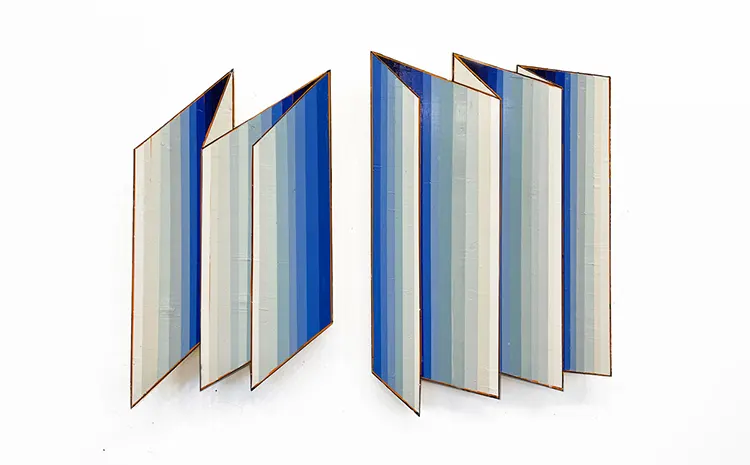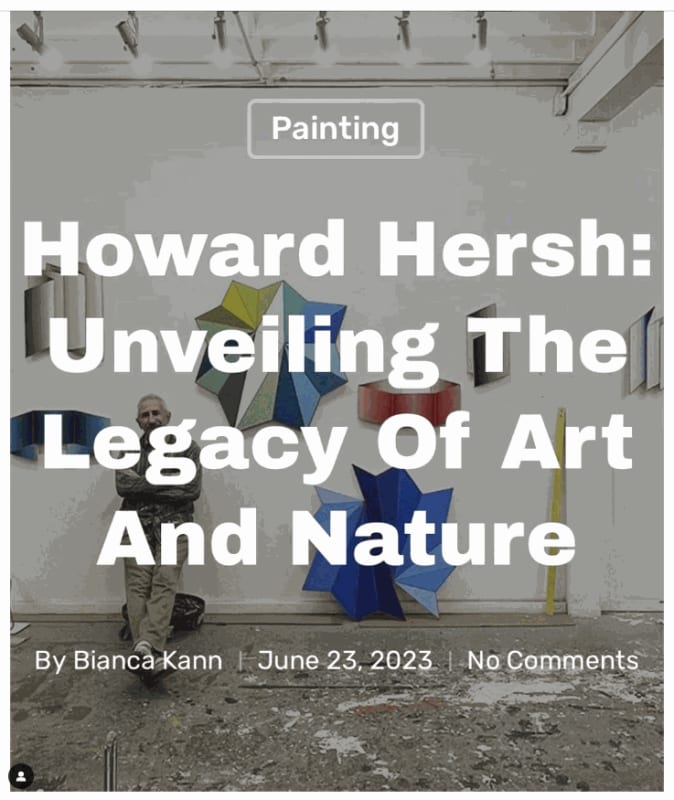“If one thing is important, everything is important.”
An Artistic Legacy Shaped by Family History
Born into a lineage steeped in art, primarily on his paternal side, Howard Hersh inherited a compelling artistic legacy. His grandfather, originally from Eastern Romania near the Black Sea, had spent his early years in the company of itinerant portrait painters, a childhood experience that imbued him with a deep love for art. Immigration led him to the United States, where circumstances dictated a return to his homeland for his parents. However, Howard’s grandfather stayed in New York, supporting himself somehow despite being only in his early teens. He demonstrated perseverance and tenacity, eventually graduating from the prestigious Chicago Art Institute.
Striking a balance between familial responsibilities and personal passions, Hersh’s grandfather operated a tailor shop while cultivating his artistic talents. However, deteriorating health eventually forced a heart-wrenching decision to forego his art. In an act of profound despair, he destroyed all his artwork, prioritizing his family’s needs over his personal aspirations. Tragically, his life was cut short at the age of 44.
In contrast, Hersh’s father enjoyed a significantly longer life of 98 years. He too harbored artistic ambitions but relegated art to the realm of hobby due to practical considerations of family responsibilities. He indulged in this ‘hobby’ quite seriously, sculpting stones for an impressive span of seven decades.
For Hersh himself, the journey unfolded differently, thanks to the confluence of opportunity and destiny. As a child, his passion for drawing was uncontainable, and he reveled in crafting things with his hands. The wood scraps his father brought home metamorphosed into buildings and model cities under his tiny fingers, hinting at an early interest in architecture.
Despite his evident proclivity, the thought of pursuing art as a profession was never fostered, likely due to his parents’ concerns about the financial viability of such a career. His initial college stint as an art major was short-lived, lacking conviction in the prospect of an artistic career. The 1960s counter culture held a greater appeal for him, and he soon left formal education behind.
The following decade witnessed Hersh’s participation in the burgeoning back-to-the-land movement. He accrued valuable life skills during this period, even delving into jewelry making for several years. A seismic shift occurred in his early 30s, when the allure of a creative life became irresistible.
In 1984, Hersh relocated to Santa Fe, New Mexico, enticed by its robust art community. Still harboring doubts about the feasibility of a career in art, he nevertheless ventured into the artistic realm. Much to his delight, he found himself earning a livelihood through his art within six months, a rewarding journey that continues to thrive nearly four decades later. Through Hersh’s life story, we see an arc of a artist who, despite initial uncertainties, ultimately found personal and professional fulfillment in his creative pursuits.

Howard Hersh: Exploring Geometric Abstraction and Architectural Perspectives
Howard Hersh’s artistic inclination and philosophical perception have been deeply ingrained by his connection with nature. After leaving New Mexico in 1998, he relocated to San Francisco to accompany his soon-to-be wife. During his tenure in the city, Hersh’s work progressively evolved into what might best be described as Geometric Abstraction. This was possibly catalyzed by his childhood pastime of constructing with sticks, which seems to have infused an architectural perspective into his present work.
Although largely a self-educated artist, Hersh has not ventured deeply into the realms of art history or academic theories. Instead, he cites his contemporaries and peers as his major influencers. Embarking on his full-time painting career in the mid-1980s, it was the artists from New York and Europe of that era who significantly shaped his artistic style. Hersh believes that artists, in their quest to refine their work, quickly transcend these influences, and the art gradually becomes a reflection of their individuality. Every artist undertakes a personal journey that must take precedence in order to aptly express their vision.
Over Hersh’s four-decade-long career, his work has undergone numerous transformations. However, his thematic exploration and philosophical fundamentals have remained unwavering. Despite his opposition to organized religions, Hersh is profoundly engaged in spiritual contemplation of life. This spiritual viewpoint manifests in his belief in the unity of creation—the absence of any division between the seen and unseen in the universe, implying the universal importance of all things.
Currently, Hersh’s favored medium is acrylic on panel. However, over his extensive career, his preference has shifted multiple times. He initially began with oil painting, subsequently exploring wax or encaustic art, and eventually settling on acrylic. Throughout these distinct phases, Hersh has extensively experimented with printmaking—primarily monotypes—and dedicated numerous years to drawing with charcoal, graphite, and inks. In addition, the past decade has seen him honing his woodworking skills.

The Transformation from Figurative to Abstract Art
In the nascent stages of his artistic career, Howard Hersh’s work primarily focused on the interplay between the human figure and the surrounding landscape. With the progression of time, the figures he painted gradually metamorphosed into more abstract and organic forms. These forms were not anchored in a tangible landscape but floated ethereally within an atmospheric expanse.
Intrigued by the concept of further fragmenting or outlining this atmospheric expanse, Hersh began to incorporate elements of geometry into his artistic repertoire. His pieces then started to reflect a profound synthesis, a unity between the natural world and mankind’s geometric and architectural constructs.
Relocating to the urban setting at the age of 49 triggered a discernible shift in Hersh’s artistic sensibilities. His work progressively adopted a geometric approach, ultimately discarding any references to organic entities. As his artistic journey evolved, geometric shapes in his creations began to assume the role of structures. This newfound structural imagery sparked his interest in depicting structures not merely as elements within the work, but as self-standing objects and schematic imageries.
Roughly a decade ago, Hersh consciously strived to create paintings that served as self-representing objects rather than mere depictions or “pictures of things”. This transformative approach spurred him to weave woodworking into his creative practice. The result was a unique collection entitled “Skin Deep”, an ironic nod to his creative journey, as his paintings laid bare their structural supports, underscoring the proverbial advice against judging a book by its cover.
In the past two years, his work underwent another evolution. While still committed to the concept of paintings as objects, the methods he employed underwent a shift. He now used illusionistic techniques to portray the structural object.
Hersh’s creative sanctuary, the studio, stands as a fundamental element in his artistic process. It serves as more than a mere physical space dedicated to producing art; it is, in fact, a source of inspiration. Merely entering the studio stirs his creative impulses. Each visit begins with revisiting the progress of the previous day’s work, thereby establishing a seamless continuum in his workflow. Even amidst periods of contemplation and thought, there exists a perpetual rhythm of creativity. In the rare interlude when the next course of action seems elusive, Hersh jestingly suggests that one could always sweep the floor. Such is the ebb and flow of his artistic life in the studio.

Howard Hersh: The Studio as a Sanctuary for Creative Expression
Hersh’s studio space, a cherished haven of creativity, is characterized by a strategic blend of practical elements such as efficient cross ventilation, spacious work tables, ample storage racks, and a harmonious blend of natural and artificial lighting. Ensuring adequate room to view his works from a distance is also essential, making his current 850 square feet space ideal, despite his experience with larger studios that span up to 2000 square feet.
Located in a repurposed Naval Shipyard, now thriving as one of the largest art colonies in the country, Hersh’s studio enjoys the tranquility of being slightly secluded, despite being within San Francisco’s city limits. Home to over 250 artists, the Shipyard offers a peaceful, creative ambiance, buffered by secured, locked gates—a welcome environment for artists who cherish solitude and minimal distractions.
One of Hersh’s standout works, “Learning Curve,” highlights the artist’s capacity for innovation. This work posed a formidable challenge during its creation, but its unique structure distinguished it as a favorite of Hersh’s and made it a prominent feature in numerous exhibitions. Its distinctive imagery served as an influential precursor to his contemporary work exploring gradients.
Hersh’s artistic prowess extends beyond traditional formats, as evidenced by his ventures into wall drawing and dimensional painting combinations. These ambitious projects have ranged from a 16-foot high and 12-foot wide piece to a collaborative effort spanning an impressive 20 feet in height and 60 feet across. These experiences have emboldened Hersh, fueling his aspiration to create an entirely enclosed room—a complete environment—employing walls, floor, and ceiling as canvases for his creativity in the future.

